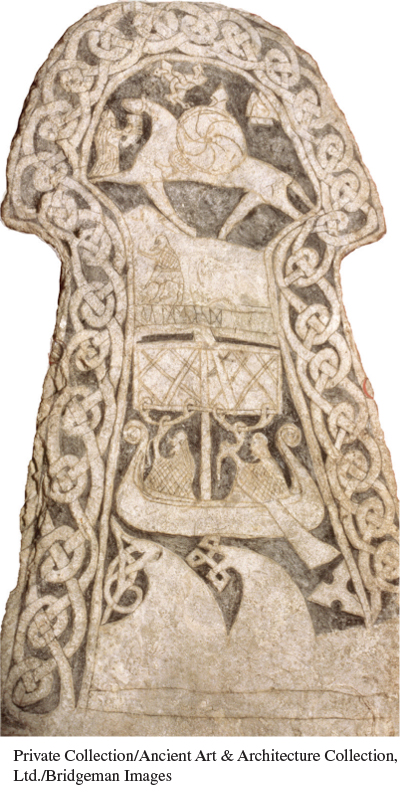Thinking Like a Historian: Vikings Tell Their Own Story
240
Vikings Tell Their Own Story
The traditional view of Vikings as bloodthirsty and ruthless marauders driven by fury comes largely from those they attacked, which included Europe’s most literate group—
| 1 | Inscriptions from runestones. The only existing written texts from Scandinavians themselves from before 1050 are runic inscriptions, primarily on memorial stones, of which thousands survive. The ones below come from the tenth and early eleventh centuries, when Christianity was spreading, so some contain Christian references. |
![]() Veda Stone, Uppland, Sweden: “Irenmuder set up this stone. He bought this estate and made his money in the east, in Gardar [eastern Russia].”
Veda Stone, Uppland, Sweden: “Irenmuder set up this stone. He bought this estate and made his money in the east, in Gardar [eastern Russia].”
Lingsberg Stone, Uppland, Sweden: “And Danr and Húskarl and Sveinn had the stone erected in memory of Ulfríkr, their father’s father. He had taken two payments in England. May God and God’s mother help the souls of the father and son.”
Uppland Stone, Uppland, Sweden: “Áli had this stone put up in his own honour. He took Knútr’s danegeld [the tribute paid to Danish invaders] in England. May God help his soul!”
Fjuckby Stone, Uppland, Sweden: “Liótr set up this stone in memory of his son, Áki. He was master of a freighter, docking in the harbors of Greece. He died at home.”
Ada Stone, Sweden: “Hermóðr had (the rock) cut in memory of Bergviðr/Barkviðr, his brother. He drowned in Lífland [Livonia].”
Vallentuna Stone, Sweden: “. . . and Ingibjôrg in memory of her husbandman. He drowned in Holmr’s sea — his cargo-
Gripsholm Stone, Södermanland, Sweden: “Tola set up this stone in memory of her son Haraldt, Ingvarr’s brother. Like men they went far to seek gold, and in the east they fed the eagle. Died south, in Serkland [‘Saracen land,’ or Muslim territory].”
Uppland Stone 1011, Uppland, Sweden: “Vigmund had this stone carved in memory of himself, the cleverest of men. May God help the soul of Vigmund, the ship captain. Vigmund and Åfrid carved this memorial while he lived.”
Sigurd Stone, Södermanland, Sweden: “Sigrid, Alrik’s mother, Orm’s daughter made this bridge for her husband Holmgers, father of Sigoerd.”
Odenslunda Stone, Uppland, Sweden: “Véketill and Ôzurr had this stone raised in memory of Eysteinn, . . .
Ingvar Stone 778, Uppland, Sweden: “Thjalfi and Holmlaug had all of these stones raised in memory of Banki/Baggi, their son, who alone owned a ship and steered to the east in Ingvarr’s retinue. May God help Banki’s/Baggi’s spirit. Áskell carved.”
Dynna Stone, Gran, Norway: “Gunnvor, Thrydrik’s daughter, made a bridge in memory of her daughter, Ástrídr. She was the most skillful girl in Hadeland.”
| 2 | Silver coin. This silver coin, minted in Hedeby in Denmark, was unearthed at Birka, an archaeological site on an island in Lake Mälaren in eastern Sweden, which in Viking times was a trading center handling goods from as far away as Byzantium and the Abbasid caliphate. |

241
| 3 | Memorial stone. This memorial stone from Gotland, Sweden, carved and erected in the eighth century, shows scenes common on early Viking memorial stones, with a mounted warrior carrying a shield above, and a ship below. |

| 4 | Carving from the side of the Oseberg cart. The Oseberg ship burial, from early ninth century Norway, contains a decoratively carved wooden cart, one side of which shows a woman with streaming hair apparently restraining a man striking at a horseman with his sword. |

| 5 | Tapestry found with the Oseberg ship. A tapestry fragment found with the Oseberg ship shows animals pulling carts; other tapestry fragments show groves of trees, battle scenes, women riding horses, houses with dragons on their gables, and ships. |

ANALYZING THE EVIDENCE
- What activities do the runic inscriptions in Source 1 highlight? What personal qualities do they praise? What do they say about people’s motivations for what they undertake?
- How are the activities and qualities descibed in Source 1 reflected in the scenes shown in Sources 2–5?
- What information do the runic inscriptions in Source 1 provide about relations among family members?
- What do the written and visual sources suggest about gender roles in Viking society?
- Why would memorial inscriptions and burials be good sources for studying social values? For what aspects of life would they not be good sources?
PUTTING IT ALL TOGETHER
Using the sources above, along with what you have learned in class and in this chapter, write a short essay that assesses the traditional view of the Vikings. How do sources from Scandinavians themselves in this era portray Viking actions, motivations, and values? What judgments of outsiders are supported, and which are refuted, in sources from insiders?
Source: (1) English translations from R. I. Paige, Runes: Reading the Past (Berkeley: University of California Press, 1987), pp. 46–51. © 1987 by the Regents of the University of California; and Rundata, the Scandinavian Runic database: www.nordiska.uu.se/forskn/samnord.htm, Department of Scandinavian Languages, Uppsala University.